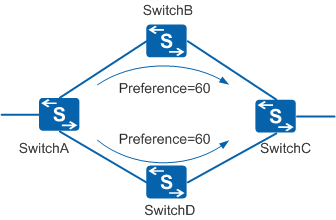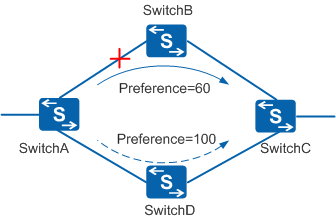Load Balancing and Route Backup
Load Balancing Among Static Routes
To implement load balancing, set the same preference value for different routes to the same destination, as shown in Figure 1.
Both static routes from SwitchA to SwitchC have a preference value of 60 and are stored in the routing table.
Route Backup
To implement route backup, set different preference values for different routes to the same destination, as shown in Figure 2.
There are two static routes with different preference values
from SwitchA to SwitchC. Static route B with next hop SwitchB has
a smaller value, which signifies a higher preference. The link associated
with static route B functions as the active link. Static route D with
next hop SwitchD has a lower preference. The link associated with
static route D functions as the standby link, providing link backup
if a fault occurs on the active link.
- In normal situations, the link associated with static route B is the active link. Static route B is included in the routing table and is used to forward data. Static route D is not included in the routing table and is not used to forward data.
- If a fault occurs on the active link, static route B is deleted from the routing table. Static route D is added to the routing table and is used to forward data.
- When the fault on the active link is resolved, static route B is reactivated, and is once again used to forward data. Static route D is deleted from the routing table and functions as the backup route.
- Static routes used for backup are also known as floating static routes.

